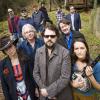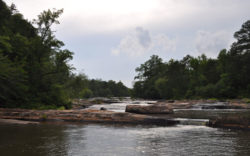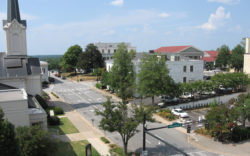An Expedition: I recently took a journey out to the spectacular Anthony Shoals, the last tumbling stretch of the Broad River before it coalesces with the series of slack reservoirs that constitute the Savannah River in this part of the state. The shoals spiderlily (hymenocallis coronaria) was the target of the journey. The shoals spiderlily only occurs in the rocky shoals of the Piedmont, and there are a few stands scattered around in South Carolina, Georgia and Alabama. This rare but impressive flower, which blooms in early May, is endangered, and largely unknown, despite its charismatic blooms. Could two-tiered blooms, sometimes six inches across, become a symbol for our Piedmont rivers, as the salmon are for the wild rivers of the Northwest?
My discovery of it came through the paintings of Philip Juras, whose stunning work often involves careful documentation and recreation of historic landscapes and ecological communities. There were a few somewhat modest clumps of the spiderlily scattered along the south bank of the river, and as I stood there, I tried to conjure up Juras’ image of the place and envision what the rivers could have been like before centuries of agriculture, pollution and damming. I also wondered if these wonderful flowers might also have once been common on the Oconee. Did my great, great grandfather once walk past them as a mill worker in Whitehall, or were they gone even then, affected by the dam that powered that factory? If they did in fact once grace the many shoals of the Oconee Rivers, might they again one day, or is the stand I saw one of the last, soon to disappear altogether? If William Bartram’s writing on the flower marked its discovery, are present-day writings like this here a eulogy for this fantastic species of ours?
Past Outing: On another recent trip, I visited Congaree National Park, just outside Columbia. The park, established as a national monument in 1976 and a park in 2003, is dubbed “the largest intact expanse of old growth bottomland hardwood forest†in the Southeast, a seemingly specific accolade. Just below the Fall Line, these woods contain some of the tallest trees in the East, with many reaching over 150 feet into the air, the tallest in the park being a Loblolly Pine, 167 feet tall and 15 feet in circumference. Bald cypress, swamp tupelo, tulip poplar, oaks and enormous American hollies are also common in the forest.
While Congaree may mark the largest such collection remaining, these floodplain forests once lined every river in the Southeast, including the Savannah and Altamaha (into which our own Oconee flows). A combination of luck and determined effort and planning allowed the Congaree forest to survive where ours haven’t. And while Congaree represents a coastal plain forest, the slopes of the Appalachians and their foothills were once dominated by equally mighty Chestnut trees; since the blight, we’ve simply forgotten them and the potential our forests really have in them.
What Was Is Not: Shifting baseline syndrome refers to the skepticism with which modern-day scientists often treat historical accounts of natural bounty. Descriptions of changes in the environment are based on the memories of a single lifetime, and as generations progress, the world each person remembers from his or her early years is progressively degraded and diminished.
Everyone ought to visit these places, just to see for him- or herself how big the world can be, to recalibrate his or her baseline for the potential that our landscapes have within them. That forests not far from Athens once held trees as mighty as redwoods is exciting, and perhaps one day they will again, but in order for that to happen, we must first accept that the world around is much diminished, and it is our fault. As a sidebar, more specifically it is the fault of those who are currently middle-aged and old, rather than the increasingly disenfranchised and belittled younger generations of Americans. It is interesting just how little of the baby boomer campaign rhetoric today has to do with what is being left for future generations.
A Crooked Line: What we do talk about quite a bit today are economics and growth, with the desperation of recession coloring so much of our decision-making. Does the road back to a less diminished natural world lie only through economics, with ecosystems services, carbon offsets and conservation tax breaks as the only ways we might set aside wild places? Even projects that couple sustainable use or harvesting and conservation still exist in economic terms. Will we ever again, as William H. Jackson once did, give great trees over to themselves, to be on their own terms?
Like what you just read? Support Flagpole by making a donation today. Every dollar you give helps fund our ongoing mission to provide Athens with quality, independent journalism.










